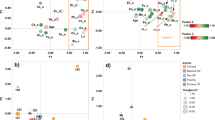Abstract
Objectives: Cast iron products are alloyed with small quantities of manganese, and foundry furnacemen are potentially exposed to manganese during tapping and handling of smelts. Manganese is a neurotoxic substance that accumulates in the central nervous system, where it may cause a neurological disorder that bears many similarities to Parkinson's disease. The aim of the study was to investigate the sources and levels of manganese exposure in foundry furnacemen by a combined measuring of blood-manganese (B-Mn) and manganese in ambient air (air-Mn). Methods: During a period of 16 months, Air-Mn and B-Mn (denoted `exposure values') were measured involving 24 furnacemen employed in three small size foundries and 21 scrap recycling workers from one plant. In the study period, 18 furnacemen had B-Mn measured 3–4 weeks after decreasing or stopping exposure (denoted `post-exposure values'). The reference group for the B-Mn measurements consisted of 90 Danish male subjects. Results: Furnacemen who work in insufficiently ventilated smelting departments inhale, absorb, and retain significant amounts of manganese in their blood (approx. 2.5–5 μg/l above reference values) despite a generally low measured airborne level of manganese fumes (0.002–0.064 mg/m3). The `exposure values' compared with `post-exposure values' revealed a significant decrease in the B-Mn (on average 3.7 μg/l) level of the most exposed furnacemen. Two persons in our study were suspected of suffering clinically subacute manganese intoxication as both had B-Mn levels beyond the normal limit (25 and 29 μg/l, respectively). The potential problem disappeared completely after cessation of exposure, and the B-Mn levels decreased to 9.4 and 14.1 μg/l, respectively. Conclusions: Risk assessment based on combined measurements of B-Mn and air-Mn seems to be valid in the interpretation of workers' hazard. Our study indicates that B-Mn may be a valuable parameter for estimating recent exposure (within 1–2 weeks). However, more knowledge is needed about the B-Mn level and its relation to neurological symptoms.
Similar content being viewed by others
Author information
Authors and Affiliations
Additional information
Received: 20 January 1999 / Accepted: 14 June 1999
Rights and permissions
About this article
Cite this article
Lander, F., Kristiansen, J. & Lauritsen, J. Manganese exposure in foundry furnacemen and scrap recycling workers. Int Arch Occup Environ Health 72, 546–550 (1999). https://doi.org/10.1007/s004200050414
Issue Date:
DOI: https://doi.org/10.1007/s004200050414




